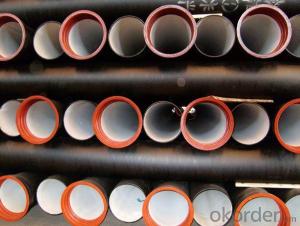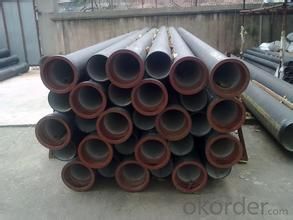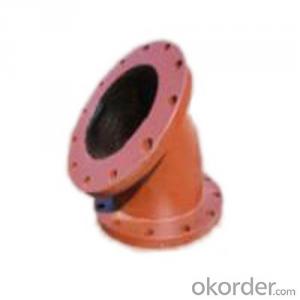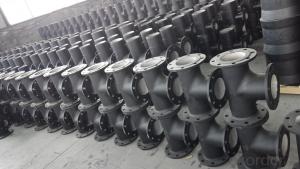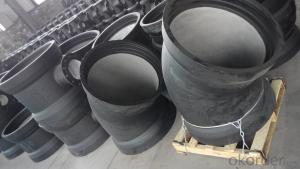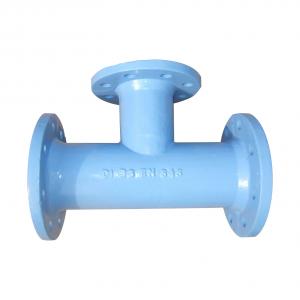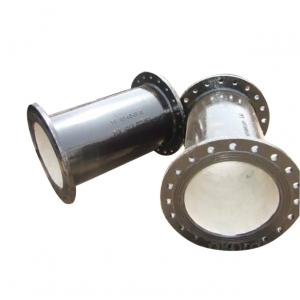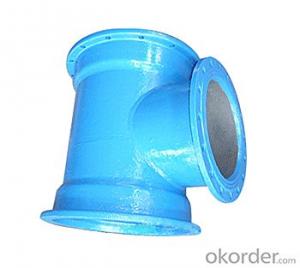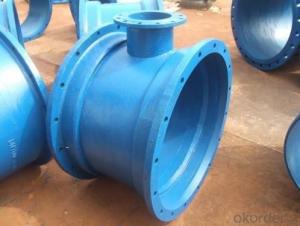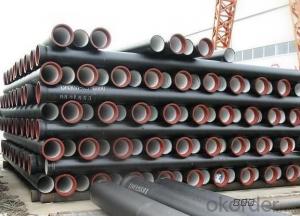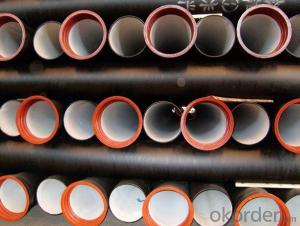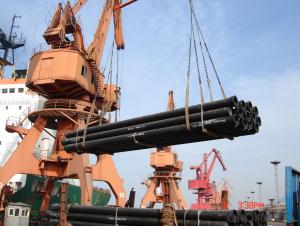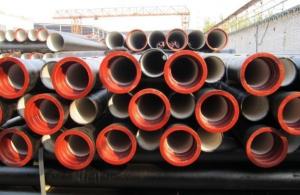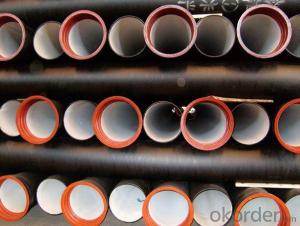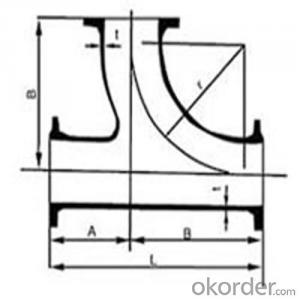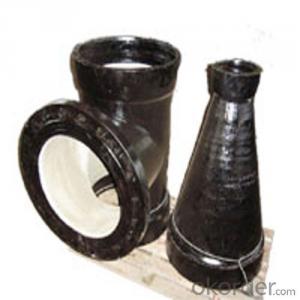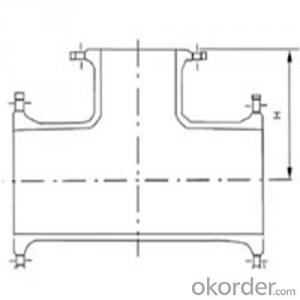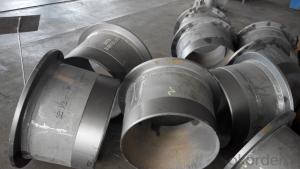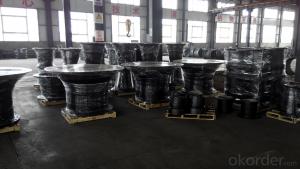Ductile Iron Pipe EN545/EN598/ISO2531 DN200-DN1000
- Loading Port:
- China main port
- Payment Terms:
- TT OR LC
- Min Order Qty:
- 30 m.t.
- Supply Capability:
- 200000 m.t./month
OKorder Service Pledge
OKorder Financial Service
You Might Also Like
1.Ductile Iron Pipe Description :
1) Pipes confirm to ISO2531,K9 class,T type joint,6m long,with inside cements lining conform to ISO4179, outside Zinc spraying(130g/m2) and bitumen coating(70μm) conform to ISO8179.
2) Pipe ends: Spigot and socket ends, with 100% SBR rubber gaskets accoding to ISO4633
3) we can do third party inspection according to customer's request.
2.Main Features of the Ductile Iron Pipe:
1. Material: Ductile iron grade 500-7/ 450-10 in accordance with ISO1083
2. Standard: ISO 2531, EN545, EN598, ANSI, AWWA
3. Certificate: ISO9001, ISO14001, SGS, NSF, WRAS
4. Test: In accordance with ISO 2531 / EN 545 / EN598 and 100% water pressure test
5. Length: 6m or cut into 5.6m, 5.7m, 5.8m
6. Internal Lining: Cement, conform to ISO4179
7. External coating: Zinc + Bitumen, conform to ISO8179
8. Rubber: NBR, SBR, EPDM according to ISO4633 / EN681.1
9. Note: The gaskets, bolts & nuts are supplied respectively as your special requirement
3.Ductile Iron Pipe Images:
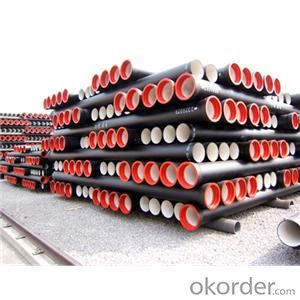
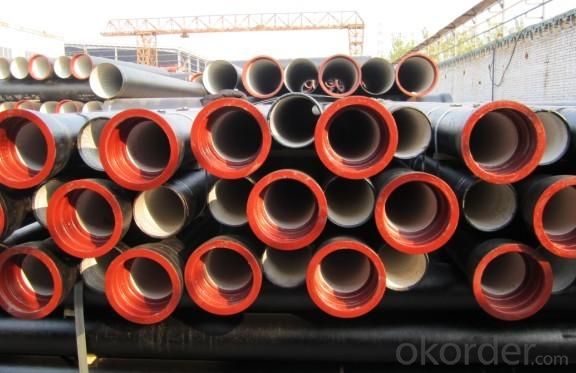
4.Ductile Iron Pipe Specification:
Standard: API SPEC 5L 44th eidtion,ASTM A252-98(2007)
Grade: A53 Grades A/B, ASTM A106 Grades B/C,ASTM A179
AWWA, C200, ASTM A139, ASTM A120, API 5L Grade B
OD size range: 6.4~44.5mm
Wall thickness: 406.4~1422mm
Length: 3 - 12 m according to requirment
Note: Other grade can also be provided after consulting. Special design are available for coal slurry conveyance LSAW line tube -- Service
5.FAQ:
1.Q: Why would you choose ductile iron pipe rather than other pipe materials?
A:The reasons are obvious for that not only ductile iron pipe possesses the inherent strength and flexibility of ductile iron, combined with proven corrosion protection systems,but also the cost savings can be achieved from design to installation and commissioning.
2.Q:Why can you guarantee the inner of pipes can’t be corroded?
A: High alumina cement mortar lining and sulphate-resistant cement mortar lining. These two special linings are applicable to inner anti-corrosion for sewage pipes, improving resistance to erosion of the sewage components.
- Q: Rowenta doesn‘t any longer seem to be reliable. Believe it or not I am halfway thinking of a mid-level to top notch Panasonic iron. Panasonic seems to be building them right. The other names if you look at the reviews and the customer service, its nothing to write home to mom about. I would be interested if you can recommend a brand either you or someone close to you have had and the iron doesn‘t leak, short out and doesn‘t become the cool iron after a few months. Thanks.
- I'm not sure there are so much better and worse irons. I used to think rowenta's were great, but they are very expensive, rather chunky and heavy and to me, don't seem to out perform other irons. For me, the best iron is the least expensive iron that meets my needs. I tend to space out that the iron is on, so I want an iron that turns itself off. I want one that has a range of settings including steam, and it's helpful, but not necessary, that it spritz water. I mostly only use irons for sewing and have owned a number, usually more than one at a time and currently own three. The things that happen to my irons is they get dropped, they get used by other folks on inappropriate things or using bad settings and spoiling them or they get so minerally or the finish wears off the face that I don't want to use them any more. It's mostly death by dropping, repeatedly though. I've never ever had a problem with them shorting, leaking or not getting hot. Iron technolody is just not that complicated, and with using distilled water (a must for with my minerally water) my irons can last for decades, despite almost abusive use when I am sewing a lot. Reviews on irons? Please. They get hot. You press things. It's not rocket science. I even have an antique cast iron iron that sits on my woodstove that I could use in a pinch, if I had to. I suggest whatever they have at Costo or Sears. Both of those stores have good return policies, so if you seem to get a lemon, you can return it. I have purchased irons at garage sales for a buck that became my favorites.
- Q: Ok so, to my knowledge, plants contain non-heme iron, which is hard for the body to absorb. However, vit c helps with the absorption (some say, the combination makes for even better absorption than heme iron) so I was thinking about kale because its a major part a my daily diet, and I thought great, it has both vit c and iron!.until I later read that calcium (which kale is loaded with) can interfere with the absorption of non-heme iron so would the calcium void the benefits from the vit c/iron combo?
- Basically none heme 3+ charge, heme iron 2+ charge. When a weak acid such as vitamin C is added, it can reduce the iron making it gain an electron which brings it to the 2+ state the more absorbable form. Heme and nonheme iron: How much iron is absorbed depends in part on its source. Iron occurs in two forms in foods, heme and nonheme. Heme iron is found only in foods derived from the flesh of animals, such as meats, poultry and fish. Nonheme iron is found in both plant and animal foods. Heme iron is so well absorbed that it contributes significant iron to the body. It is absorbed at a relatively constant rate of about 23%. The rates of absorption of nonheme iron are lower, ranging from 2 to 20%, and are strongly influenced by dietary factors and body iron stores. People with severe iron deficiencies absorb heme and nonheme iron more efficiently and are more sensitive to dietary enhancing factors than people with better iron status. Some dietary factors bind with nonheme iron, inhibiting absorption. These include the phytates and fibers in whole grain cereals and nuts, the calcium and phosphorus in milk and supplements, the EDTA in food additives, and tannic acid. Tannic acid is present in tea, coffee, nuts and some fruits and vegetables. Recent studies reveal that soy may inhibit iron absorption
- Q: Does anyone know if chelated iron pills are okay to take while pregnant?And what does chelated mean anyways?Thanks!
- Wow stay in school. I dont know what to sayreally.
- Q: Or was the iron before the toaster? Who invented them and when?
- The electric toaster was invented in the U.S.A. in 1926, the Iron has been around since the mid 1800's, but the electric iron I can't find but I'm betting it was first. I have a book called Great events of the 20th century, and that is how I know about the toaster.
- Q: why does tin can when scratched rust much quicker than an iron can coated with zinc (galvanised) when it becomes scratched ?
- Iron is more reactive than tin so it will protect the iron from rusting better since iron can react better with oxygen in the air.
- Q: I do not give the jar meat she eats what we eat and we eat meat about 4 times a week she fats around 25 oz of alimentum formula idk how else to get her iron up. My iron is always low also we are both very pale skinned any advice on what else to do
- Their are many foods rich in iron that you could add to her regular diet to supplement what she is getting from the meat. I have low iron all the time too, and its mostly cause i eat like no meat.not vegetarian i just dont really like it so i try to eat alot of dark green things and and meat replacement like beans and such. beans, including kidney, lima, navy, black, pinto, soy beans, and lentils greens, including collard greens, kale, mustard greens, spinach, and turnip greens tofu broccoli, swiss chard, asparagus, parsley, watercress, brussel sprouts Those are a few i pulled off that website that are foods high in iron other than meats but there are quite a few resources out their for cooking iron rich. You could also go with iron fortified foods with an artificial iron but that doesnt tend to digest in the body as well as a natural iron. I hope you can get it figured out.
- Q: is it true that during the war people used to put iron nails into apples to increase the iron content and then eat the apples??
- I'm not sure about the nails in the apple bit but I do know that cast iron skillets are supposed to add iron to the foods cooked in them. I read that it was only trace amounts but with consistent use the skillets could help an iron deficiency. I found a link to the information, it is below. The tetanus thing might be true with a rusty nail. I'm reluctant to do the whole nail into food thing myself. :) About the lead poisoning. only if the nail was lead.
Send your message to us
Ductile Iron Pipe EN545/EN598/ISO2531 DN200-DN1000
- Loading Port:
- China main port
- Payment Terms:
- TT OR LC
- Min Order Qty:
- 30 m.t.
- Supply Capability:
- 200000 m.t./month
OKorder Service Pledge
OKorder Financial Service
Similar products
Hot products
Hot Searches
Related keywords
